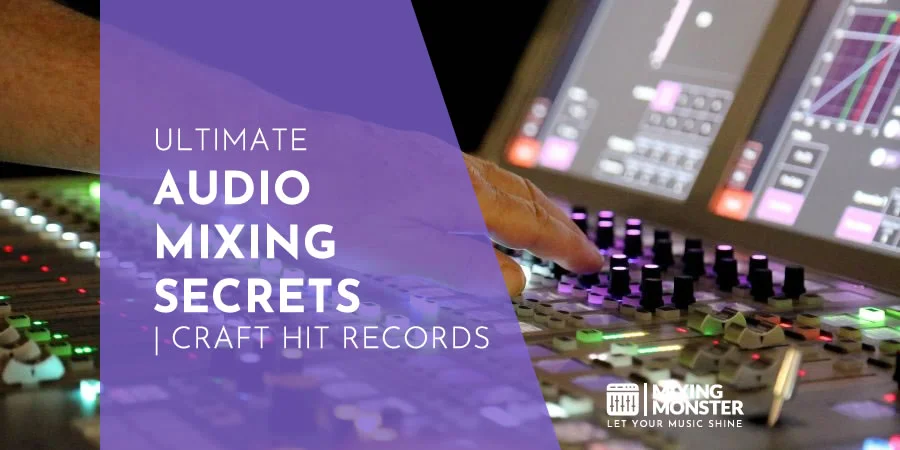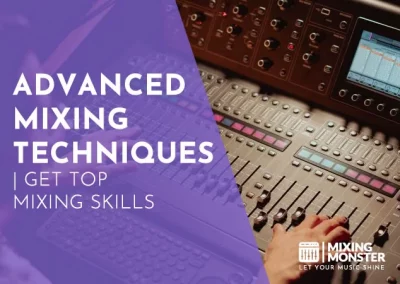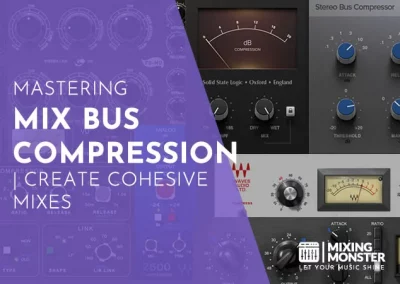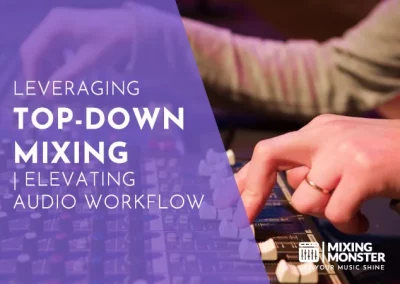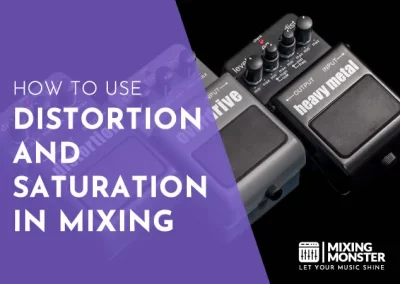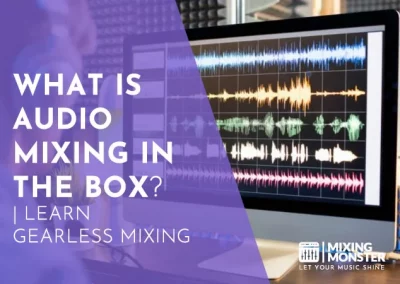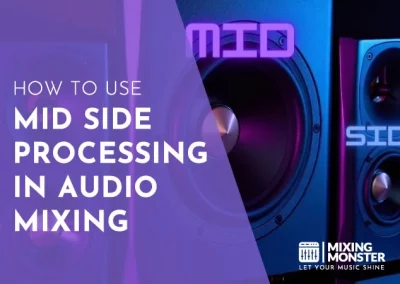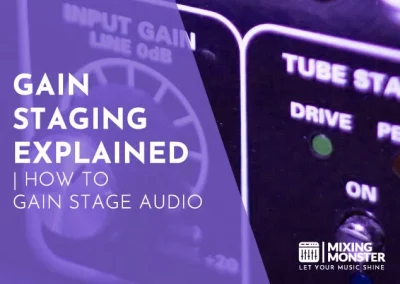Home > Blog > Mixing > Mixing Techniques
Disclosure: Some of the links below are affiliate links, meaning that at no additional cost to you, we will receive a commission if you click through and make a purchase. Read our full affiliate disclosure here.
“Mixing secrets” are the elusive skills and techniques that set professional mixes apart from amateur efforts, ensuring each element within a song is polished and perfectly placed.
“Mixing Secrets” refers to audio engineers’ techniques and methods to produce a polished final track. These often-undisclosed tricks are key to achieving a professional sound. They encompass strategic use of EQ, panning, and effects. Mastery of these secrets allows for clarity and balance in a mix. The term encapsulates the art and science behind compelling audio mixes.
With many mixing approaches and tools available, you’re poised to unlock the potential of your music. This article serves as a guide, providing insights into everything from basic methods to advanced genre-specific strategies, aiming to refine your mixes with the efficiency of a professional audio engineer.
KEY TAKEAWAYS:
- Mixing is an essential step in music production that determines the quality of the final track.
- Fundamental and advanced techniques are crucial for creating a professional-sounding mix.
- Efficient workflows and an understanding of industry secrets are key to successful mixing.
Table Of Contents
1. Fundamental Mixing Secrets
2. Advanced Mixing Techniques
3. Genre-Specific Mixing Secrets
4. Mixing In The Box Vs. Analog
5. The Psychology Behind A Hit Mix
6. Mixing Workflow And Efficiency
7. Mastering The Final Touch
8. Keeping Up With Industry Mixing Standards
9. Mixing Bonus Tips And Tricks
10. Audio Mixing Secrets Unveiled
11. FAQ

1. Fundamental Mixing Secrets
In mixing, the balance of elements and clarity of sound are paramount. Mastery over dynamic range, EQ, and spatial positioning form the core of professional-sounding tracks. Let’s explore these foundational aspects to elevate your steps in the mixing process.
The Foundation Of Mixing
You start your mix with monitoring tactics that ensure accurate sound reproduction. This involves choosing the right speakers and positioning them to minimize room reflections. Understand the limitations of your studio and use tools like reference tracks to calibrate your mixing environment.
Dynamic Range Control
Dynamic range—the variance between a track’s loudest and softest parts—is crucial in mixing. Use compression to tame peaks and enhance quieter sounds, thus achieving a consistent level throughout. Careful compression applications can add punch and presence without sacrificing the natural dynamics of a performance.
Stereo Field And Spatial Effects
The stereo field is your canvas; placing elements within it requires a thoughtful approach. Panning to spread instruments across the left and right channels creates space and dimension. EQ and reverb are potent tools for placing elements front-to-back, helping you sculpt a three-dimensional mix.
2. Advanced Mixing Techniques
In this section, you’ll discover methods to elevate your mixes beyond the basics. You’ll learn to enrich harmonics, apply modulation creatively, and infuse your tracks with emotional depth.
Harmonic Enhancement
Your mix can gain a new level of warmth and clarity by carefully applying EQ. Target your instruments’ fundamental frequencies and harmonics and boost them slightly for added presence. This technique helps make individual elements of your mix distinct and full-bodied, ensuring each instrument sits perfectly within the mix.
Creative Use Of Modulation Effects
Modulation effects such as chorus, flangers, and phasers can transform a static mix into a dynamic soundscape. Use these effects sparingly to add movement to pads, guitars, or background vocals. Automating the rate and depth of these effects will create a sense of evolution throughout your track, leading to a more engaging listening experience.
Mixing For Emotion
Beyond technical proficiency, mixing involves psychological tricks to evoke emotions. Deliberate editings, such as strategic silences or unexpected volume swells, can surprise listeners and convey the desired feeling. Remember, your goal is to guide the listeners’ emotional response, using tools like reverb for depth or brightness adjustments for mood to serve the song’s emotional core.
3. Genre-Specific Mixing Secrets
In this section, we navigate the nuances of mixing distinct musical genres. Your ability to create release-quality mixes hinges on understanding and applying these genre-specific techniques.
Rock And Metal Mixing Secrets
The guitar’s clarity and the drums’ aggressiveness are paramount in rock and metal. Utilizing high-pass filters to clean up low-end mud allows the bass guitar to sit well with the kick drum. For guitars, consider adding a slight boost around 1.5 kHz to highlight their presence in the mix.
Electronic Music Mixing Secrets
For electronic music, harnessing stereo imaging tools can help synthesize that expansive, chart-ready sonic landscape. Synths and pads benefit from side-chain compression against the kick for a pumping effect, a signature in this genre. Pay close attention to synths and lead sounds, giving them room to breathe in the mix with EQ cuts on competing instruments.
Hip-Hop And R&B Mixing Secrets
The low-end in hip-hop and R&B must be present and controlled, so tools like multiband compression on the bass can yield a tight yet powerful bottom range. Vocals must cut through with both warmth and definition, utilizing EQ to add clarity around 3 kHz and subtle saturation for fullness. Moreover, pitch correction software can aid in achieving the polished vocal performance often desired in these genres.
Acoustic And Jazz Mixing Secrets
Acoustic and jazz music thrive when the natural sonic qualities are preserved; thus, a discreet and minimalist approach with acoustic treatment is essential. Careful microphone placement and a judicious use of reverb can maintain the authenticity of acoustic instruments. For jazz, ensure that each instrument’s unique timbral quality stands out, often achieved by subtle EQ and avoiding over-compression.
4. Mixing In The Box Vs. Analog
The debate between mixing “in the box” (ITB) and using analog equipment remains central to achieving your desired sound in audio production. Your choice impacts not just the sonic character of your mix but also your workflow, budget, and final output quality.
The Best Of Both Worlds
Mixing in the box offers a level of convenience and affordability unattainable in traditional analog settings. You can reproduce commercial-grade results with plugins that emulate vintage hardware within your Digital Audio Workstation (DAW). This means access to a wide array of tools without the associated cost of physical outboard gear.
Analog mixing, however, is praised for its warmth and sonic character. The subtleties of analog summing and the tactile experience of using physical faders and knobs can contribute to a more intuitive mixing process. Yet, this often comes with higher costs and a need for more space to house the equipment.
Hybrid setups are becoming more prevalent, where you can benefit from the tactile control of analog desks or outboard mix-buss processing while retaining the recall and flexibility of digital systems. By strategically integrating affordable gear, you can approach the quality of high-end studios without a massive investment.
Balancing between in-the-box advantages and analog allure comes from personal preference, specific project requirements, and budget considerations. Your goal is always to serve the music best and ensure that your technical choices always enhance, not hinder the creative process.

5. The Psychology Behind A Hit Mix
The impact of a mix on a listener’s emotions and decisions can’t be overstated. This section examines the crucial roles of creating an emotional connection and the decision-making process when mixing music.
Emotional Connection In Mixing
Your mix should resonate emotionally with listeners to create a lasting impact. Successful producers often employ subtle psychological tricks to enhance the emotional content of a track. For example, the strategic use of reverb can make a vocal feel distant or intimate, altering the dynamic landscape of the song.
Decision-Making In Mixing
The choices you make during mixing can make or break a track. Consider every element; even minute adjustments can change the listener’s perception. For instance, nuanced EQ tweaks can highlight a particular emotion in a vocal performance, while drastic changes might introduce energy in a chorus to excite the listener. Your decisions should always serve the song and its intended emotional message.
6. Mixing Workflow And Efficiency
Efficient workflow is integral to professional mixing practice, enabling you to deliver high-quality results promptly. As a professional engineer, mastering the art of streamlining your process and handling revisions is essential for productivity and client satisfaction.
Streamlining Your Mixing Process
To enhance your mixing process, begin by establishing a standardized template. This template should contain your most commonly used tracks, buses, and plugins, saving valuable setup time for each project.
Additionally, use keyboard shortcuts and macro commands; these tools can drastically reduce the time to perform repetitive tasks, allowing you to focus on the creative aspects of mixing.
Consolidating tracks before mixing can also lead to increased efficiency. For example, combining multiple drum microphones into a single drum bus or stem not only simplifies the visual aspect of your mix but can also assist in applying cohesive processing to grouped elements.
Mix Review And Mix Revisions
After completing a mix, take a moment to listen critically and evaluate your work in different listening environments. Be sure to listen on various systems, such as studio monitors, headphones, and consumer speakers, to ensure translation across different playback scenarios.
When it’s time for revisions, track and categorize each piece of feedback methodically for an organized approach. Create a checklist enumerating specific issues, such as vocal levels, low-end balance, or stereo imaging adjustments. Tackling revisions with a clear plan minimizes the time spent and helps maintain objectivity in your mixing decisions.
7. Mastering The Final Touch
Mastering is your final step in the audio production journey, transforming your mix into a polished, cohesive final product. It’s essential for ensuring consistency and playback quality across all listening environments and formats.
Pre-Mastering Tips
Before you hand off your mix for mastering, performing a thorough check is crucial. Ensure your tracks are free of clicks, pops, or unwanted noise. Confirm that the highest peak level of your mix doesn’t exceed -6dBFS to allow adequate headroom for mastering. Preparing your mixes correctly is vital to a smooth mastering process.
The Mastering Handoff
When passing your mix to a mastering engineer, provide detailed notes regarding your vision for the sound. Include references to tracks with a desired tonal balance to guide the mastering direction. Clear communication and well-prepared mixes are the cornerstones of a successful mastering handoff, paving the way for the final touch your track needs.
8. Keeping Up With Industry Mixing Standards
In the ever-evolving field of audio production, staying current with industry mixing standards is crucial for your growth and relevance. It requires a commitment to continuous learning and nurturing professional relationships, leveraging both to remain at the forefront of technological advancements.
Continuous Learning In Mixing
Your journey through the audio mixing landscape is an ongoing process. Engage with materials from leading-edge engineers to keep your skills sharp and informed. Online courses, video tutorials, and industry insider webinars can provide you with the latest mixing techniques and an understanding of plugin technology that shapes the sound of modern records.
Collaboration And Networking In Mixing
Building a network of professionals is paramount. Collaborate with industry experts to exchange knowledge, tips, and experiences. This not only helps you understand diverse mixing methodologies but potentially offers access to cutting-edge plugin technology and insights into the workflows of successful engineers.
9. Mixing Bonus Tips And Tricks
In this section, we’ll reveal some quick fixes that can transform your mixes and explore how to work with budgets of all sizes. It’s about knowing the right moves and when to make them, regardless of the gear at your disposal.
Quick Mixing Fixes And Secret Sauce
Consider leveraging compression to add punch and presence to lifeless tracks to elevate your mixes swiftly. For instance, parallel compression on drums can give them a thunderous impact without squashing the dynamics. Another trick is to automate EQ for different sections of a track, making subtle boosts or cuts to create movement and interest throughout the mix.
Mixing At Different Budget Levels
Within a limited budget, focus on acquiring affordable gear that can significantly impact your sound. Good-quality headphones or entry-level studio monitors will be your most valuable assets. Even with modest equipment, applying mixing secrets for the small studio, like strategic microphone placement and careful gain staging, can yield professional-sounding results.
10. Audio Mixing Secrets Unveiled
In this section, you’ll consolidate the mixing knowledge you’ve acquired, explore ways to tailor unique mixing techniques, and look ahead to discovering new mixing methods.
Recap Of Ultimate Audio Mixing Secrets
- Monitor Setup:
Ensuring accurate sound reproduction. - Signal Processing:
Utilizing EQ, compression, and effects strategically. - Gain Staging:
Maintaining proper levels throughout the mix. - Automation:
Adjusting elements dynamically for interest and balance.
These foundational secrets have been the cornerstone of achieving a polished, professional-sounding mix.
Experiment And Develop Personal Mixing Techniques
Your creative input and experimentation with different techniques shape your unique sound. By building on the core concepts of mixing, you can:
- Test unconventional signal chains for unexpected sonics.
- Shape space and depth using reverb and delay sends creatively.
These practices encourage you to think outside the box and mold mixes that stand out.
Inventing Your Mixing Secret
As you gain experience, you might stumble upon a technique that feels like your secret weapon. This could be anything from a signature compression setting to a novel way of mixing an instrument.
Embrace these discoveries—they’re what differentiate your style from others. Keep an open mind and always be willing to adapt and improve your approaches.
11. FAQ
1) What essential techniques are required to achieve a professional mix in a home studio?
Firstly, ensure you have a well-treated listening environment to assess sounds accurately. Use high-quality monitors and headphones; rely on reference tracks to guide your mix decisions.
2) Can you recommend any resources for learning advanced mixing strategies?
Our upcoming mixing courses offer structured learning for advanced techniques. Also, consider online communities and workshops for continual learning.
3) What steps should be taken to prepare for a successful mix session?
Prepare by organizing and labeling tracks, creating a rough balance, and setting goals for the session. Also, check for any technical issues with the audio files before beginning the mix process.
4) How can one obtain multitracks for mixing practice without any cost?
Websites like Cambridge Music Technology provide free multitracks for educational purposes. It’s essential to respect the terms of use when using these tracks.
5) What common mistakes should be avoided to ensure a clear and balanced mix?
Avoid overprocessing with effects, neglecting to carve out space for each instrument, and mixing at consistently high volumes, which can lead to ear fatigue.
6) How do I critically evaluate and improve my mixes based on established mixing principles?
Systematically assess your mixes by comparing them to professionally mixed tracks and gather objective feedback from peers. Use tools such as spectrum analyzers to identify issues visually.

